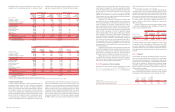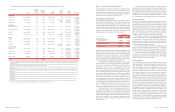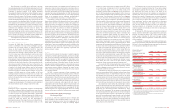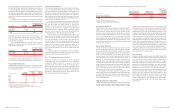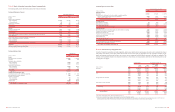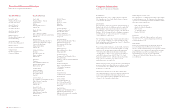Bank of America 2003 Annual Report Download - page 52
Download and view the complete annual report
Please find page 52 of the 2003 Bank of America annual report below. You can navigate through the pages in the report by either clicking on the pages listed below, or by using the keyword search tool below to find specific information within the annual report.
Bank of America, N.A. and BAS are also defendants in an adver-
sary proceeding pending in the United States Bankruptcy Court for the
Southern District of New York. The proceeding is brought by the Official
Committee of Unsecured Creditors in the Adelphia Bankruptcy
Proceedings (the Creditors Committee) on behalf of Adelphia; however,
the Bankruptcy Court has not yet given the Creditors Committee
authority to bring this lawsuit. The adversary proceeding complaint
names over 400 defendants and asserts over 50 claims under federal
statute (including Bank Holding Company Act), state common law and
various provisions of the Bankruptcy Code. The Creditors Committee
seeks avoidance and recovery of payments, equitable subordination,
disallowance and recharacterization of claims and recovery of dam-
ages in an unspecified amount. Bank of America, N.A., BAS and other
investment bank defendants have filed motions to dismiss. The
Official Committee of Equity Security Holders in the Adelphia
Bankruptcy Proceedings has filed a motion seeking to intervene in the
adversary proceeding and to file its own complaint. The proposed com-
plaint is similar to the Creditor's Committee complaint, except that it
also asserts claims under RICO and various state law theories.
The Corporation cannot determine at this time the eventual out-
come, timing or impact of these matters.
Paul J. Mille r v. Bank of Ame rica, N.A.
On August 13, 1998, Bank of America, N.A.’s predecessor was
named as a defendant in this class action challenging its practice,
consistent with the banking industry, of debiting accounts that
receive, by direct deposit, governmental benefits to repay fees
incurred in those accounts. The action alleges fraud, negligent mis-
representation and violations of certain California laws. On October
16, 2001, a class was certified consisting of more than one million
California residents who have, had or will have, at any time after
August 13, 1994, a deposit account with Bank of America, N.A. into
which payments of public benefits are or have been directly deposited
by the government. The case proceeded to trial on January 20, 2004.
On February 25, 2004, at the conclusion of the jury phase of the trial,
the jury found in Bank of America, N.A.’s favor on three of the four
claims presented to the jury. As to the fourth claim, alleging that Bank
of America, N.A. violated certain California laws, the jury imposed
damages of approximately $75 million and awarded the class repre-
sentative $275,000 in emotional distress damages. The jury also
assessed a $1,000 penalty as to those members of the class
suffering substantial economic or emotional harm as a result of the
practice but did not determine which or how many class members are
entitled to the penalty. This and other legal issues remain outstand-
ing in the trial court.
The Corporation believes that this case is without merit and plans
to appeal any adverse judgement. The Corporation cannot determine at
this time the eventual outcome, timing or impact of this matter.
D.E. Shaw Litigation
Following the merger of NationsBank Corporation and BankAmerica
Corporation in September 1998, the Corporation and certain of its offi-
cers and directors were named as defendants in class actions brought
on behalf of persons who purchased NationsBank or BankAmerica
shares between August 4, 1998 and September 30, 1998; persons
who purchased shares of the Corporation between October 1 and
October 13, 1998, and persons who held NationsBank or
BankAmerica shares as of the merger. The claims on behalf of the pur-
chasers and the persons who held NationsBank shares as of the
merger principally rested on the allegation that the Corporation or its
predecessors failed to disclose material facts concerning a $1.4 bil-
lion financial relationship between BankAmerica Corporation and D.E.
Shaw & Co. that resulted in a $372 million charge to the Corporation’s
earnings in the quarter ending September 30, 1998. The claims of the
persons who held BankAmerica shares as of the merger principally
rested on the allegation that the defendants misrepresented a
“takeover” of BankAmerica Corporation as a “merger of equals.”
On November 2, 2002, the United States District Court for the
Eastern District of Missouri (the Federal Court), the Court to which all
federal actions had been transferred, entered a final judgment dis-
missing the actions with prejudice. The Federal Court entered the
judgment after approving a settlement providing for payment of $333
million to the classes of purchasers and holders of NationsBank
shares and $157 million to the classes of purchasers of
BankAmerica and Corporation shares and holders of BankAmerica
shares (all amounts to bear interest at the 90-day Treasury Bill Rate
from March 6, 2002 to the date of payment). The Eighth Circuit Court
of Appeals affirmed the judgment on appeal by certain objecting
plaintiffs and class members on December 2, 2003, and denied a
petition for rehearing on January 9, 2004. It is expected that, in
accordance with its terms, the settlement will become final in April
2004 unless further review is sought in the Supreme Court of the
United States. There remain pending several actions in California that
have been stayed since April 2000, when the Federal Court enjoined
the plaintiffs in those actions from purporting to prosecute their
claims on behalf of a class.
Re gulatory
In the course of its business, the Corporation is subject to regulatory
examinations, information gathering requests, inquiries and investiga-
tions. Two of the Corporation’s subsidiaries, BAS and Banc of America
Investment Services, Inc. (BAI), are registered broker/dealers under
the federal securities laws and are subject to regulation by the SEC,
the National Association of Securities Dealers, the New York Stock
Exchange and state securities regulators. In connection with several,
formal and informal, investigations by those agencies, BAS and BAI
have received numerous requests, subpoenas and orders for docu-
ments, testimony and information in connection with various aspects
of its regulated activities.
The SEC is currently conducting a formal investigation with
respect to certain trading and research-related activities of BAS dur-
ing the period 1999 through 2001. To date, the SEC staff has not
indicated whether it intends to recommend any enforcement action in
connection with these trading and research-related activities. On
December 30, 2003, however, BAS was advised by the SEC staff that
it does intend to recommend action against BAS with respect to
alleged books and records violations related to the preservation and
production of materials requested during the investigation of the trad-
ing and research-related activities. BAS is cooperating with the SEC
staff with respect to the ongoing investigation and is also working
with the staff to reach a resolution of the books and records matter.
Note 14 Shareholders’ Equity and Earnings
Per Common Share
On January 22, 2003, the Corporation’s Board of Directors (the
Board) authorized a stock repurchase program of up to 130 million
shares of the Corporation’s common stock at an aggregate cost of
$12.5 billion. At December 31, 2003, the remaining buyback
authority for common stock under this program totaled $4.3 billion,
or 24 million shares. On December 11, 2001, the Board authorized
a stock repurchase program of up to 130 million shares of the
Corporation’s common stock at an aggregate cost of up to $10.0 bil-
lion. The 2001 repurchase plan was completed in 2003. On July 26,
2000, the Board authorized a stock repurchase program of up to 100
million shares of the Corporation’s common stock at an aggregate
cost of up to $7.5 billion. The 2000 repurchase plan was completed
in 2002. During 2003, the Corporation repurchased approximately
129 million shares of its common stock in open market repurchases
and under an accelerated repurchase program at an average per
share price of $75.76, which reduced shareholders’ equity by $9.8
billion and increased diluted earnings per common share by approxi-
mately $0.22. These repurchases were partially offset by the
issuance of 70 million shares of common stock under employee
plans, which increased shareholders’ equity by $4.2 billion, net of
$123 million of deferred compensation related to restricted stock
awards, and decreased diluted earnings per common share by
approximately $0.16 in 2003. During 2002, the Corporation repur-
chased approximately 109 million shares of its common stock in
open market repurchases at an average per share price of $68.55,
which reduced shareholders’ equity by $7.5 billion and increased
diluted earnings per common share by approximately $0.22. These
repurchases were partially offset by the issuance of 50 million shares
of common stock under employee plans, which increased sharehold-
ers’ equity by $2.6 billion and decreased diluted earnings per com-
mon share by approximately $0.11 in 2002. During 2001, the
Corporation repurchased approximately 82 million shares of its com-
mon stock in open market repurchases at an average per share price
of $57.58, which reduced shareholders’ equity by $4.7 billion. These
repurchases were partially offset by the issuance of 27 million shares
of common stock under employee plans, which increased sharehold-
ers’ equity by $1.1 billion. The Corporation will continue to repur-
chase shares, from time to time, in the open market or private
transactions through its previously approved repurchase plan.
On January 28, 2004, the Board authorized a stock repurchase
program of up to 90 million shares of the Corporation’s common
stock at an aggregate cost not to exceed $9.0 billion and to be com-
pleted within a period of 18 months.
At December 31, 2003, the Corporation had 1.3 million shares
issued and outstanding of ESOP Convertible Preferred Stock, Series
C (ESOP Preferred Stock). The ESOP Preferred Stock has a stated
and liquidation value of $42.50 per share, provides for an annual
cumulative dividend of $3.30 per share and each share is convertible
into 1.68 shares of the Corporation’s common stock. ESOP Preferred
Stock in the amounts of $4 million for 2003 and $7 million for both
2002 and 2001 was converted into the Corporation’s common stock.
Accumulated OCI includes pre-tax net unrealized gains (losses)
related to available-for-sale debt and marketable equity securities,
foreign currency translation adjustments, derivatives and other of
$(3.8) billion, $2.7 billion and $1.9 billion at December 31, 2003,
2002 and 2001, respectively. The net change in accumulated OCI
also includes adjustments for gains (losses) to net income during the
current year that had been included in accumulated OCI in previous
year ends. Pre-tax adjustments for gains included in the Consolidated
Statement of Income for 2003, 2002 and 2001 were $1.4 billion,
$780 million and $715 million, respectively. The related income tax
expense (benefit) was $(1.8) billion, $1.1 billion and $30 million in
2003, 2002 and 2001, respectively.
The Corporation has, from time to time, sold put options on its
common stock to independent third parties. The put option program
was designed to partially offset the cost of share repurchases. The
put options give the holders the right to sell shares of the
Corporation’s common stock to the Corporation on certain dates at
specified prices. The put option contracts allow the Corporation to
determine the method of settlement, and the premiums received
were reflected as a liability subsequent to the adoption of SFAS 150;
prior to that, these put options were reported as a component of
other shareholders’ equity and were accounted for as permanent
equity, and accordingly, there was no impact on the income state-
ment. No other derivative contracts are used in the Corporation’s
repurchase programs. As of December 31, 2003, all put options
under this program had matured and there were no remaining put
options outstanding.
At December 31, 2003, there were no premiums on written put
options. Included in shareholders’ equity at December 31, 2002 were
premiums on written put options of $47 million. Included in share-
holders’ equity at December 31, 2003 and 2002 were restricted
stock award plan deferred compensation of $154 million and $31
million, respectively.
The calculation of earnings per common share and diluted earn-
ings per common share for 2003, 2002 and 2001 is presented below.
See Note 1 of the consolidated financial statements for a discussion
on the calculation of earnings per common share.
(Dollars in millions, except
per share information;
shares in thousands)
2003 2002 2001
Earnings per common share
Net income
$10,810 $9,249 $ 6,792
Preferred stock dividends
(4) (5) (5)
Net income available to
common shareholders
$10,806 $9,244 $ 6,787
Average common shares
issued and outstanding
1,486,703 1,520,042 1,594,957
Earnings per common share
$7.27 $6.08 $ 4.26
Diluted earnings per
common share
Net income available to
common shareholders
$10,806 $9,244 $ 6,787
Preferred stock dividends
455
Net income available to
common shareholders and
assumed conversions
$10,810 $9,249 $ 6,792
Average common shares
issued and outstanding
1,486,703 1,520,042 1,594,957
Dilutive potential
common shares(1,2)
28,475 45,425 30,697
Total diluted average
common shares
issued and outstanding
1,515,178 1,565,467 1,625,654
Diluted earnings per
common share
$7.13 $5.91 $ 4.18
(1) For 2003, 2002 and 2001, average options to purchase 9 million, 22 million and 85 million
shares, respectively, were outstanding but not included in the computation of earnings per
common share because they were antidilutive.
(2) Includes incremental shares from assumed conversions of convertible preferred stock,
restricted stock units and stock options.
100 BANK OF AMERICA 2003 BANK OF AMERICA 2003 101








